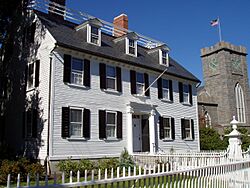Ropes Mansion facts for kids
Quick facts for kids Ropes Mansion |
|
|---|---|

The Ropes Mansion, with First Unitarian Church in the background
|
|
| General information | |
| Type | House |
| Architectural style | Georgian |
| Location | Salem, Massachusetts |
| Address | 318 Essex Street |
| Coordinates | 42°31′16″N 70°53′59″W / 42.5212°N 70.8998°W |
| Completed | c. 1727 (PEM) c. 1729 (MACRIS) |
The Ropes Mansion is a beautiful old house in Salem, Massachusetts. It's officially called the Nathaniel Ropes Mansion. This large home is located at 318 Essex Street. It was built in the Georgian Colonial style, which was popular a long time ago.
Historians believe the mansion was built in the late 1720s. Over the years, it has been changed and updated. For example, a fancy entrance was added in the 1800s. The house was also moved back from the street. This might have been to make room for a wider road. Today, the Peabody Essex Museum takes care of the Ropes Mansion. You can even take tours of the house during certain times of the year.
Contents
History of the Ropes Mansion
Early Days: Samuel Barnard's Home
The Ropes Mansion was first built for a wealthy merchant named Samuel Barnard. He moved to Salem from Deerfield, Massachusetts in 1720. Barnard had survived a difficult attack in Deerfield in 1704. He became very successful in Salem.
When the house was first built, it had two and a half stories. It was covered in wooden clapboards. The roof was a special style called a gambrel roof. Samuel Barnard lived in the house until he passed away in 1762. After his death, his nephew sold the house.
The Ropes Family Takes Over
In 1768, Judge Nathaniel Ropes bought the mansion. He was a very important person in Salem. Nathaniel Ropes studied law at Harvard University. He became a lawyer and later served in the colonial government. He was also a judge for many years.
Judge Ropes became involved in a big disagreement. This was about how judges were paid. He was friends with important American leaders like John Adams. However, Judge Ropes also had some loyalist views. This meant he supported the British King.
Around the time of the American Revolutionary War, some angry people gathered outside his house. They were protesting his loyalist beliefs. It is said this happened in March 1774. Judge Ropes was very ill with a serious sickness at the time. He passed away the day after the protest.
Changes and Modernization
The Ropes family continued to live in the house for many generations. In 1807, the inside of the house was updated. Around 1830, the main entrance was changed. It got fancy columns in the Ionic style. Several rooms and the main hallway were also remodeled.
More big changes happened in 1894. A new section, called an "ell," was added to the back of the house. This included a kitchen and service area. The house was also moved further back from Essex Street. Modern updates like electricity and plumbing were added. The inside was redecorated in the Colonial Revival style. The white wooden fence you see today was also put up.
The Ropes family lived in the mansion until 1907. The last three Ropes sisters passed away that year. In their will, they gave the house to the "Essex Institute." They wanted it to be a memorial to their family. They also hoped it would be used for a school about plants.
In 1912, a beautiful formal garden was created behind the house. Today, the Ropes Mansion is part of the Peabody Essex Museum. The museum offers self-guided tours. They limit the number of people inside at one time to protect the historic home.
Other Interesting Places Nearby
- The Witch House – another historic building on Essex Street
- List of historic houses in Massachusetts

